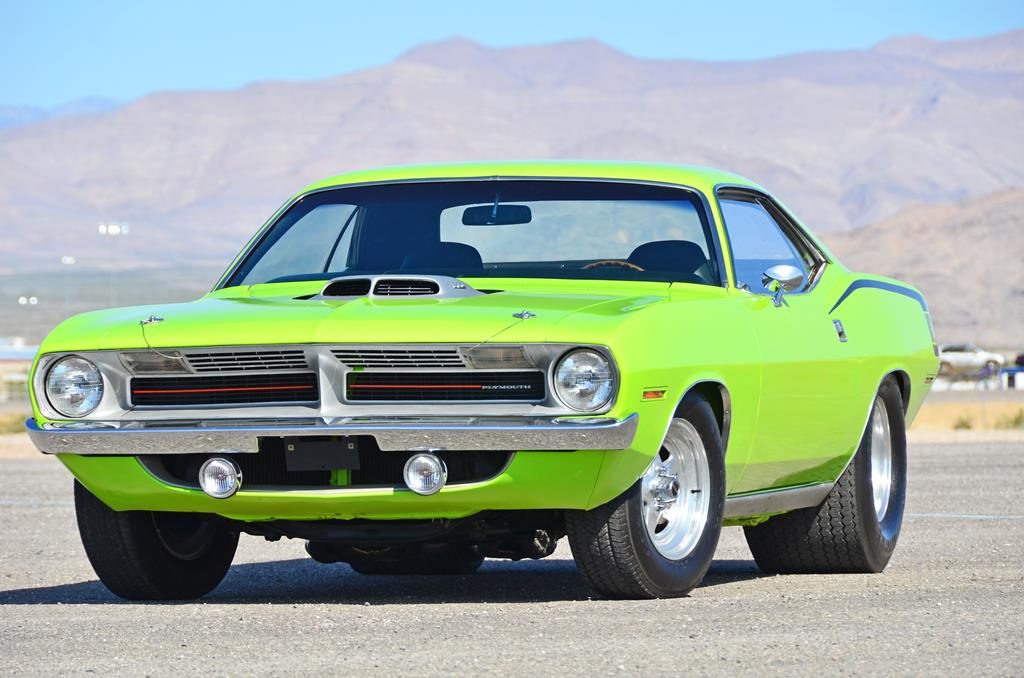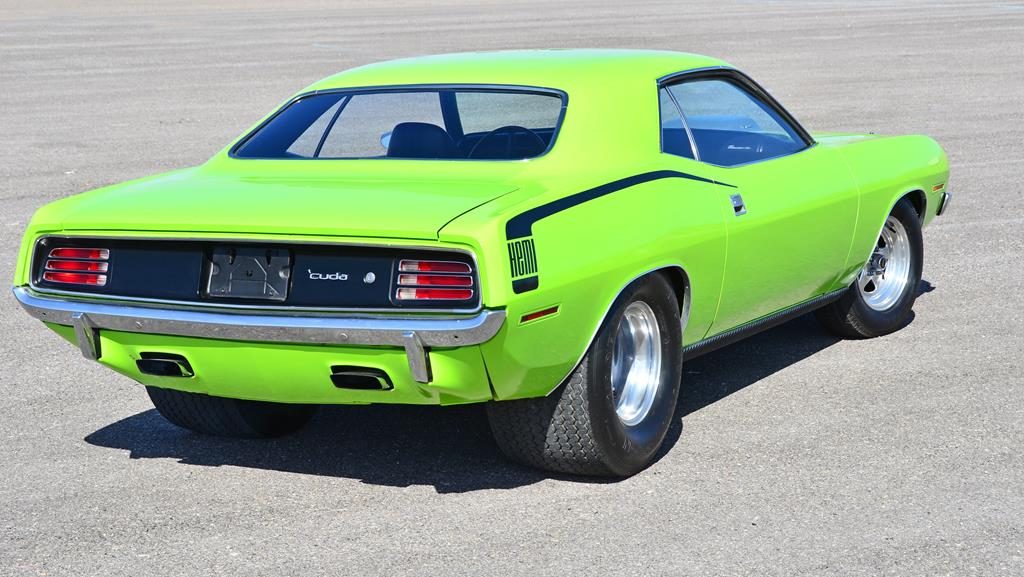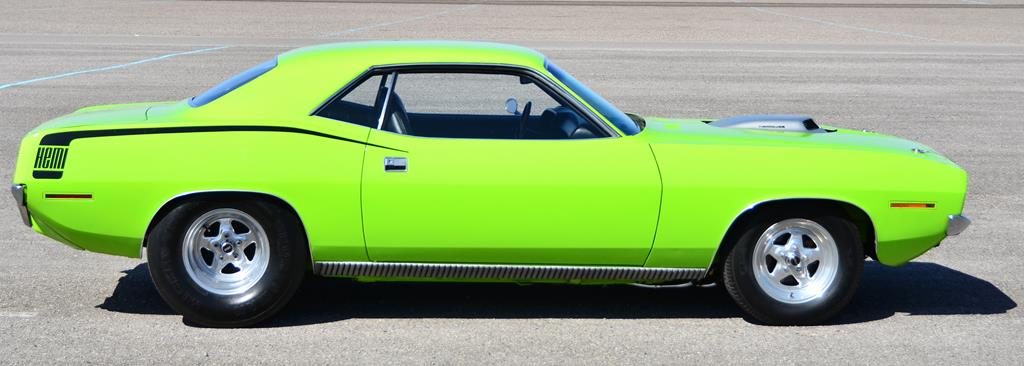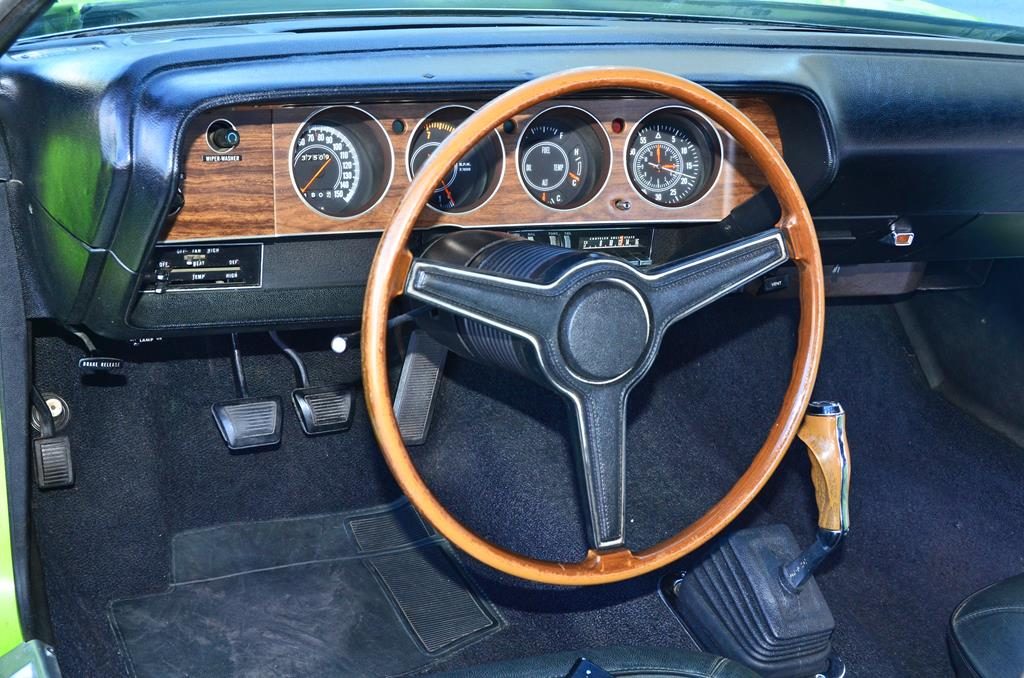Poster Power
The story behind the Lime Light 1970 Hemicuda in the BF Goodrich tire ad.
By Al Dente Photos by TheBruntBros

Hemicuda was in Canada all its life until it was bought in 1987 by Marty Ahlgrim in Southern CA. the Plymouth had been tubbed and fitted with a Direct Connection leaf link (sorta like a 4-link with leaf springs) and was said to have run in the 10s.
It really was a cool ad: an empty blue sky except for a few white puffy clouds. The head line read ‚ÄúThe Goodrich Blimp,‚ÄĚ a spoof on the Goodyear blimp. ‚ÄĚ the ad went on to read ‚ÄúWe‚Äôre the other guys.‚ÄĚ More recent was the BF Goodrich ad campaign that featured a series of musclecars, ioncluding a 1970 Hemicuda. The ads were striking in that they were monochrome. In the case of the ‚ÄėCuda, the entire ad matched the car‚Äôs Lime Light hue.
Those who saw the ad may have wondered where BFG found the car for their ad. Was it a pristine, stock Hemicuda out of some collection or museum? That might have been the case if the ad had been crafted by class-act Goodyear. But these were ‚Äúthe other guys.‚ÄĚ So if you‚Äôre wondering what is the story behind the Lime Light poster car, here‚Äôs the deal.

BF Goodrich’s ad agency headed by former Pop Hotrodding tech editor, C. Van Tune found Marty’s car through Roland Osborne, publisher of Chrysler Power. The shot the car with the rear on jack stands and removed the road lamps and rocker gills. They swapped Marty’s Weld Pro Star wheels and tires on the passenger side for a set of BFGs on Foose wheels.
Rod Souder, in Penticton B.C bought the ‚ÄėCuda new on Dec. 24th 1969 at Johnston Motors in Vancouver B.C. Within 3 days after getting the car home, Rod and bud Dale Gerry hosed on a full ‚Äė70s-style custom paintjob. In the early spring of 1970, Rod moved to Vancouver and got a job as service manager at Cal-Van Auto Supply, was the premier Speed Shop in the area at the time. One of the perks was easy access to the shop‚Äôs wheel dyno. Minor mods‚ÄĒheaders, tune and 8‚ÄĚ slicks prepped the ‚ÄėCuda for racing.

A Super Track Pak 4-speed car, the rear is a 4.10 Dana. Marty had TTi cobble up a 3‚ÄĚ exhaust system. He had to go with shorter Mustang rear leaf springs in order to fit the stock exhaust tips through the openings in the valence panel.
The Hemi took a turn for the worse late in 1970 when Rod downshifted at high speed and threw a rod. He took the Plymouth back to Johnston motors and was told (remember this was 1970) that the engine was covered under warranty ONLY if it had heavy grade oil AND 2 pints of STP. The oil was sent to the test lab for analysis at the University of British Columbia and passed the test. So Johnston coughed up a replacement Hemi.


The hand fab’d boxed frame connectors are still in the chassis from the car’s race days. The car still looks as good as it did on the poster.
With 9000 miles rolled up on his 12-Month /12,000-Mile warranty, Rod figured he‚Äôd better get out while the getting was good. So he traded the ‚ÄėCuda in to a small car dealer in Vancouver. There‚Äôs no info on the car‚Äôs history from ‚Äô70-‚Äė77 which is when Mike Bizuick bought the car, still wearing its original custom paint, and he turned the car into a serious drag racer where he was able to get it into the 10s. Mike went for new custom paint sprayed by Dale Gerry who originally painted the ‚ÄėCuda. Mike raced the car at a small track near Dawson Creek B.C in the years that followed as well as other tracks in Alberta and St. John, B.C. It was also Raced at Fort St. John B.C. The car was sold to another Canadian, Paul Murtagh, who in turn sold it in 1987 to its current owner, Marty Ahlgrim in southern CA.

Dick Landy built the Hemi to the tune of 650 HP. The original block went south when the first owner executed an untimely downshift. Arlen Vanke reworked the intake manifold for better mid-range torque. Marty made his own shaker hood using an original as a template to cut the hole in a flat steel hood. The shaker base plate and bubble are NOS.
When Marty first got the car, it had parachutes wrapped around it with diesel exhaust all over it. Silver prism tape on both quarter panels spelled out ‚ÄúTHE CAPTAIN‚ÄĚ over a Lime Light base color with a burgundy stripe down the center and across the back. Under a fiberglass 6-pack hood was a 426 Street Hemi connected to a 4-speed and 4.10 Dana 60. The rear had been tubbed with a leaf-link suspension right out of the old Direct Connection Chrysler Performance chassis book.

Sparse options include an AM/ 8-track 3-speaker radio. Interior is all original except for new front seat covers by Legendary.
Marty sent the engine out to Dick Landy who poked it .020‚ÄĚ fitted a Kellogg crank, his special ‚Äútight-fit‚ÄĚ pistons and Landy‚Äôs ‚Äúspecial‚ÄĚ Street Hemi cam. The package is said to be good for 650 HP. Arlen Vanke did his thing on the intake, cutting down and knife edging the center divider for better mid range. The body went to Ahltech where it was stripped and painted Lime Light. Since repro sheetmetal wasn‚Äôt available at the time the only way to return the tubbed rear to stock would be with donor cars. So the rear was left as is. Underneath, the DC leaf-link setup was removed and the leaf spring suspension restored‚ÄĒsort of. Marty wanted to run the factory exhaust tips at the ends of the 3‚ÄĚ TTi exhaust system, through the stock valence openings. But when the rear had been narrowed the rear spring shackle blocked the valence opening. Going to Chariot Spring, Marty learned ‚Äė65-‚Äė67 Mustang leaf springs are the same width as the Mopar E-body springs, and the same length from the spring center to the front shackle, but 5‚ÄĚ shorter from the center to the rear shackle form front of leaf springs to center of rear end is same length Mustang is 5‚ÄĚ shorter, So Marty had the shackle move forward for the needed exhaust tip clearance.¬† But the springs don‚Äôt handle the torque very well when Marty gets on it.
Hemicuda was a factory shaker car. Original owner gave it a ‚Äė70s psychedelic paintjob. Don‚Äôt stare at this shot too long or you risk taking a ‚Äúbad trip.‚ÄĚ (Photo: Rod Souder)
Since he had all that room in the tubbed rear, Marty went with some big meats‚ÄĒ18.5 x 31‚ÄĚ MTs mounted on Weld Pro Star wheels which were becoming all the rage at the time. The rest of the sheetmetal, except for the hood is original.
In April 1993, Marty‚Äôs friend, the Right Honorable Reverend Roland Osborne, publisher of Chrysler Power, received got a call from C.Van Tune, formerly the tech editor of Popular Hotrodding, and later, editor of Motor Trend. Van Tune had left the publishing world to open his own ad agency and BFG was one of his first clients. BFG figured Van Tune knew where to get the car for their ads, and right they were. He knew Roland was the go-to guy for Mopars, and that‚Äôs where he went. Roland contacted Marty and asked if he wanted in on the deal. Hey, does a bear etc.? Marty wanted the ‚ÄėCuda to look special, so he canned the fiberglass 6-pack hood in favor of a flat steel hood. He got another shaker hood to use as a template to cut the shaker hole in his hood and came up with an NOS base plate and bubble. He finished the job on a Saturday in the rain. BFG picked up the car Sunday in the rain and trucked it to a sound stage in Hollywood where it was prepped for the shoot. (Sound stage? Yeah, the ad has sound‚ÄĒbut only in the Chrysler Power ads).
This is how Marty received the car from Canada‚ÄĒwrapped in parachutes. (Photo: Marty Ahlgrim)
When Marty and his wife showed up at the studio for the shoot, they found the ‚ÄėCuda sitting on a stage about 5-6 feet high with a green curtain about 15 feet in front of the car. Studio lights between the curtain and the car made the ‚ÄôCuda sparkle. It looked surreal. There was a green backdrop behind the car which had the passenger side facing the camera. The rear axle was on jack stands, and the photo crew had swapped Marty‚Äôs wheels just on the passenger side with Foose wheels and BFG tires.
The driver‚Äôs side still had Marty‚Äôs big MT in the rear. If you look at the rear tire in the original poster, you‚Äôll notice a 2‚ÄĚ black line in front of the passenger rear tire‚ÄĒthat‚Äôs the MT skin showing through. The crew had removed the rocker gills and the road lamps and painted the ends of his chrome bumpers with a washable Lime Light. While painting over the green fenderwells in a washable black. BFG didn‚Äôt want green showing around the tires. Marty was kind of upset about the items that had been removed from the ‚ÄėCuda, but the BFG folks reminded him that they were selling tires, not cars, and they didn‚Äôt want any elements taking away from the focal point of the BFGs.
Once the ‚Äėchutes were off, the ‚ÄėCuda, in race trim, showed a 6-pack hood and ‚ÄúTHE CAPTAIN‚ÄĚ emblazoned on the quarters. (Photo: Marty Ahlgrim)
In return for his ‚ÄėCuda serving as BFG‚Äôs Mopar poster car, Marty was offered a choice of $500 or a set of BFGs. He took the money and ran‚Ķto start a college fund for one of his daughters. In return for our mentioning Chrysler Power in our magazine, Reverend Roland was offering Mopar Action readers discount tickets -‚Äďfor rides in the Goodrich blimp (to heaven?)

